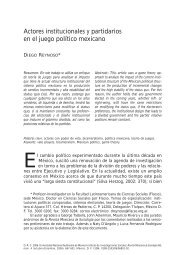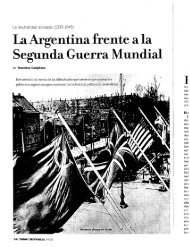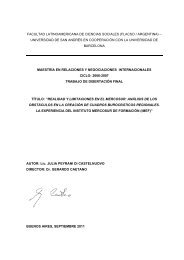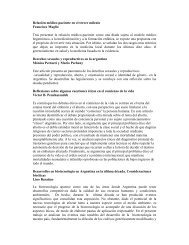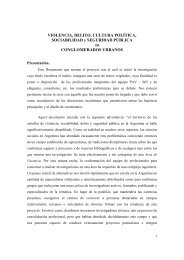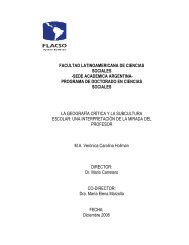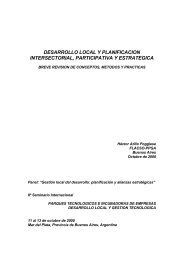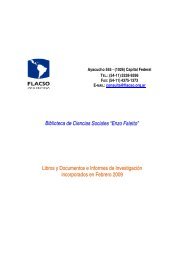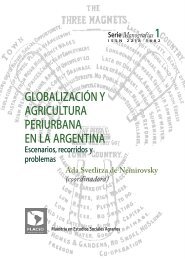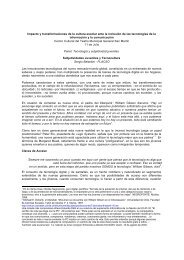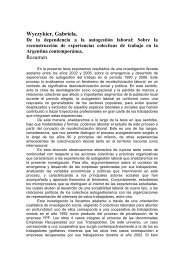Mercedes Botto Andrea Carla Bianculli - Flacso
Mercedes Botto Andrea Carla Bianculli - Flacso
Mercedes Botto Andrea Carla Bianculli - Flacso
Create successful ePaper yourself
Turn your PDF publications into a flip-book with our unique Google optimized e-Paper software.
Between 1976 and 1979, the program of José Martínez de Hoz, the military-appointed civilian<br />
Minister of Economy, was a heterodox and often contradictory mix of price and exchange controls,<br />
selective tariff reduction, privatization, and state expansion. In terms of the trade policy, the reform<br />
program was uneven: while between 1976 and 1982, the average tariff rate on imports declined<br />
from 55 to 22%, a nucleus of branches producing intermediate goods considered to be “strategic”<br />
retained high tariff protection: steel, aluminium, pharmaceutical, petroleum and derivatives,<br />
transport material, and cement4. In any case, this uneven reform process was abandoned after the<br />
crisis that hit Argentina in 1979, which led to a sharp deterioration in the current account and the<br />
balance of payments, and the subsequent debt crisis of 1982. Quantitative restrictions would be<br />
then re-established in order to reduce imports and in turn, the commercial deficit.<br />
The first constitutional government would leave these measures in place, and by the end of 1983 it<br />
would also introduce a system by which products were classified according to whether they could<br />
be imported or not. Moreover, tariffs were increased since 1982, and by 1987 they would range<br />
from 0 to 105%, though the average tariff was 37% and the mode, 38%. In sum, between 1985 and<br />
1987, the predominant tariff was 53% 5.<br />
The newly elected president Raúl Alfonsín resisted strict austerity and market liberalizing measures.<br />
However, the designation of Juan Sourrouille and a new technical team of economists in the<br />
Ministry of Economy would entail an important change in 1985. This new economic team,<br />
although far from orthodox, agreed that a new economic program, including trade policy reform<br />
was needed, and that same year the Austral Plan would put trade liberalization on the agenda, which<br />
became an issue of debate between government and business. In spite of these changes, the process<br />
of trade liberalization as a unilateral policy would not start until 1988 with the so-called “Canitrot<br />
Reform” 6. While on the tariff side there was a reduction in nominal protection – the average import<br />
tax was reduced from a level of 45% in 1987 to 29% at the end of 1988 – in terms of non-tariff<br />
measures, there was an important reduction of tariff positions that were subject to quantitative<br />
restrictions: the number of products subject to prohibition or quantitative restrictions was reduced<br />
from 4.000 to 3.000, and the average tariff rate was reduced from 51 to 36% [de la Balze, 1995].<br />
Hence, by the late 1988, there was progress in the trade liberalization agenda. In addition, by 1988,<br />
attitudes within Argentine public officials toward far-reaching reform were already changing in<br />
substantial ways.<br />
Nevertheless, the decisive and final implementation of the trade liberalization reform would come<br />
hand in hand with the closer relationship between Argentina and the International Monetary Fund<br />
(IMF) and the World Bank, which would play a more definitive role in shaping the reform policy in<br />
Argentina, particularly in terms of trade policy, public sector reform, and privatization. Moreover,<br />
4 It is noteworthy that some of these industries were in the sectors controlled by the military.<br />
5 When looking at the multilateral level, we find that since World War II, trade negotiations had reduced<br />
average tariffs on manufactured and semi-manufactured goods from 40% in 1947 to less than 10% by the<br />
mid-1970s. By 1986, a new set of trade talks – the Uruguay Round of Multilateral Trade Negotiations – had<br />
already begun, and this would lead to a tariff figure of approximately 5% in the early 1990s.<br />
6 Adolfo Canitrot was then Under Secretary of Planning, Ministry of Economy.<br />
10



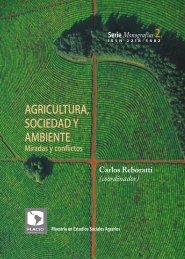
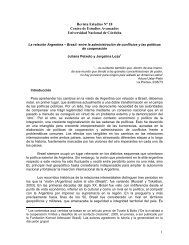
![[P] Disertacion.Melisa.Galvano.pdf - Flacso](https://img.yumpu.com/14596629/1/184x260/p-disertacionmelisagalvanopdf-flacso.jpg?quality=85)
